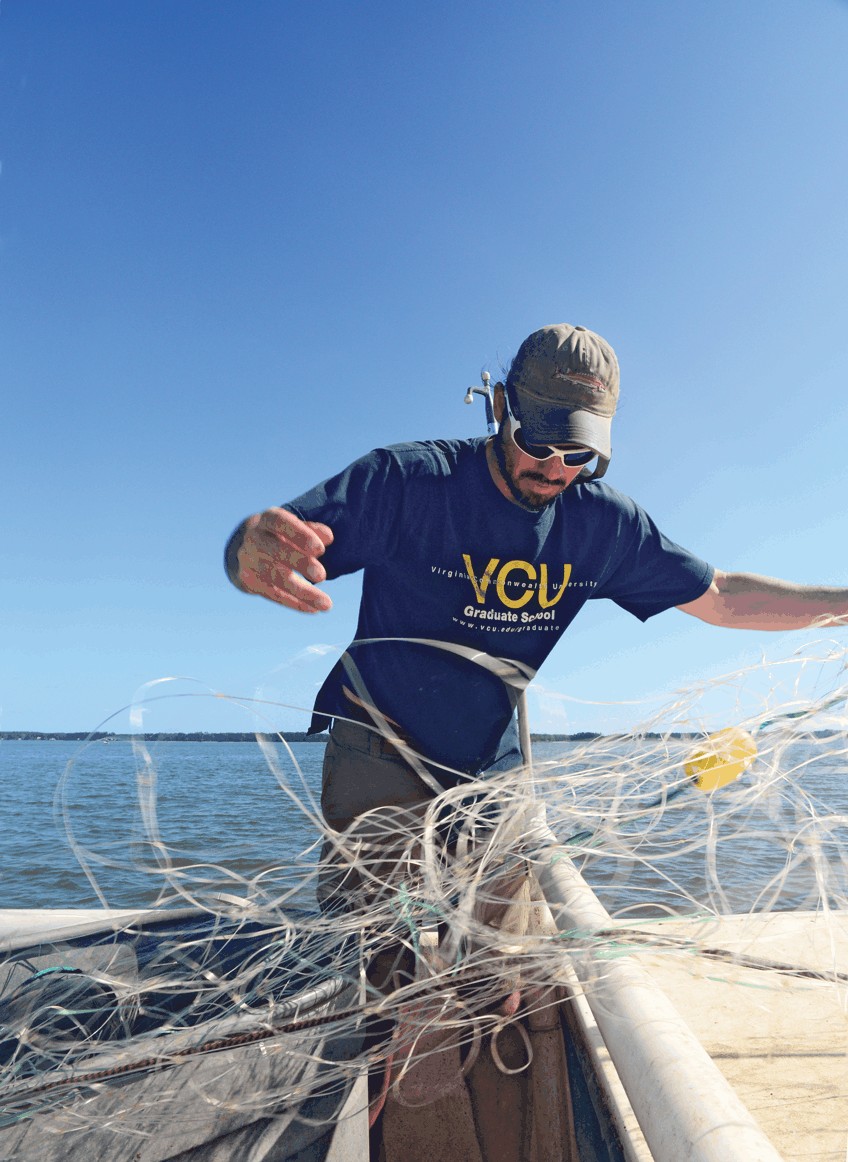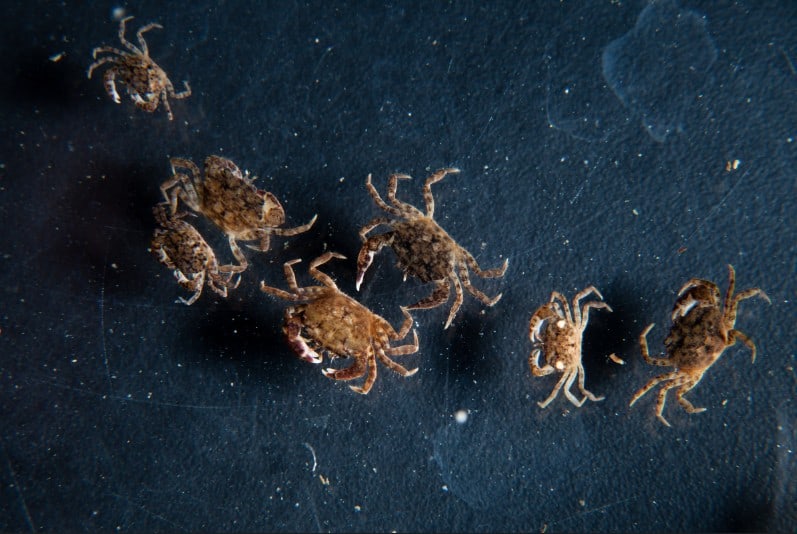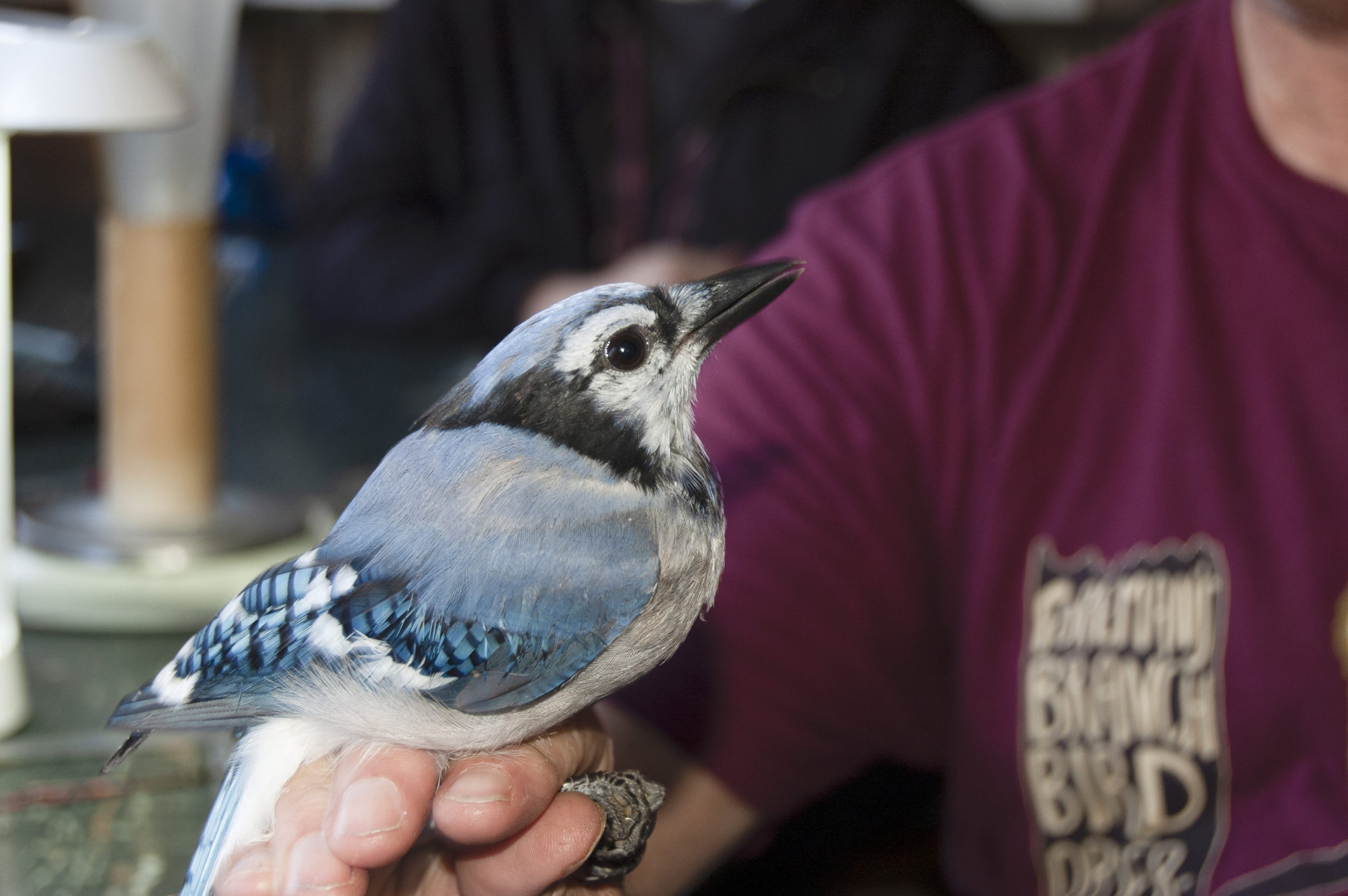Beneath us, dinosaurs are moving. On the console of the 27-foot scow workboat, which is flecked stem to stern with mud, bits of seaweed and other evidence of benthic struggle, a black box is beeping erratically. Matt Balazik watches the box intently, every now and then erupting with a number it reads. Each number is a tag, each beep is an Atlantic sturgeon.
Through a hydrophone Balazik has dangled overboard, the box—a telemetry tracking receiver—blurts out its recognition of fish moving around beneath us here on the James River, just off Fort Eustis. Most of these are heading for the Atlantic Ocean after spawning upriver. A fall spawn, which no one knew was happening, of a fish no one thought was still native to the Chesapeake—an ancient animal that had been deemed by fisheries scientists as “functionally extirpated.” Meaning gone, from a Bay where John Smith once described them as so thick you could walk across their backs, where the Jamestown settlers depended upon them to survive what would soon become the Starving Time.
Balazik, a former member of the research faculty at Virginia Commonwealth University’s Center for Environmental Studies, grew up on this river. He and his family knew stories of sturgeon here, but no one had seen any for decades. Then one day, he saw what he believed to be a sturgeon leap from the water.
“He really couldn’t avoid asking, ‘What’s going on?’ ’’ says Dave Secor, a professor and fisheries scientist at the Chesapeake Biological Laboratory on the Patuxent River, part of the University of Maryland’s Center for Environmental Science. So Balazik started doing what no scientist had done: fishing for sturgeon. What he found has since turned the scientific community on its head.
“I’ve been so wrong about sturgeon, because we didn’t really know anything about them,” Secor says. “We live in this digital age where we’re humbled by these dinosaurs. That something as big as a sturgeon escaped our notice for twenty years . . . I called them ghosts of the past. It was Matt’s early work that changed my mind about everything.”
Today, we’re out on the James to watch Balazik continue his work tagging, tracking and documenting sturgeon in the James River. Now a research ecologist for the U.S. Army Corps of Engineers Research and Development Center in Vicksburg, Miss., Balazik still returns to the James each spring and fall to learn more about the fish that so enthralls him, he wears one beautifully rendered as a tattoo on his inner arm.
“In 2004, a Chesapeake Bay Foundation trawl caught one, a small one,” Balazik says. “Watermen knew they were here, but we didn’t know they were spawning here. In 2007, we started to fish upstream; 2007 just proved we had no idea what we were doing. In 2010 we started to hone in on it, figure out good ways to do it.
“You gotta realize, this fish has gone through two of the massive extinctions, and then we come along and almost smoke them in a century,” he says. “It’s got the whole relic thing, bones on the outside, cartilage on the inside. It’s a fish that went way out in left field, and found something that worked. The fish that saved Jamestown. It’s a good ecosystem indicator of oxygen levels and sediment. It’s the canary in the coal mine for the river.”
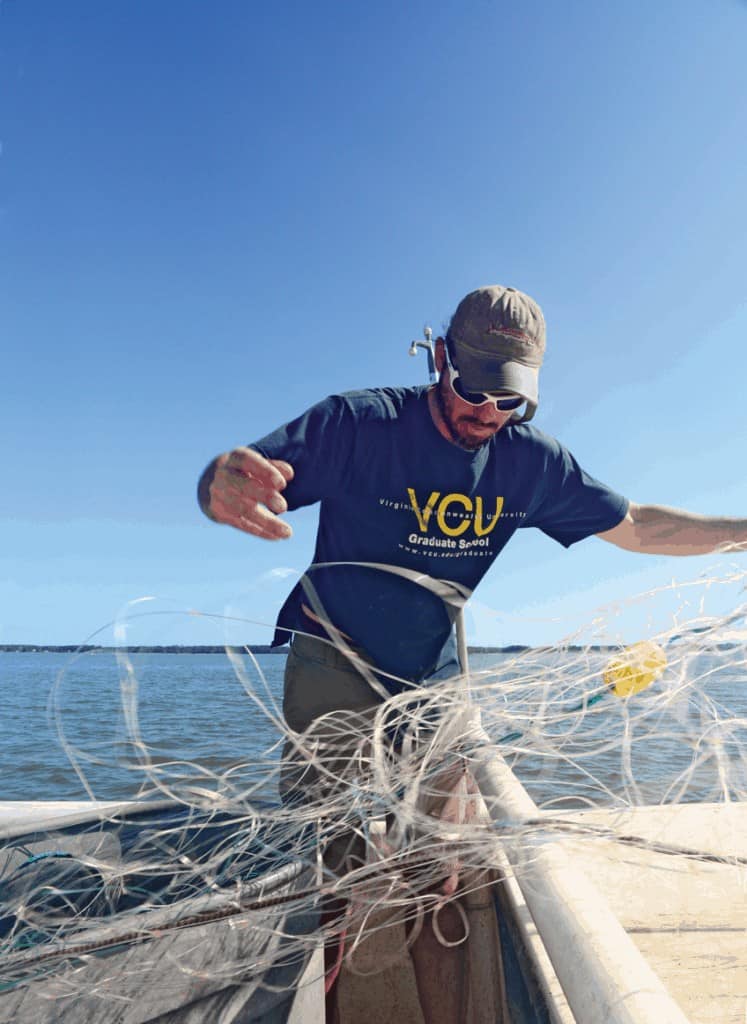
All of these facts explain why this fish so captivates Balazik and others. But there’s something else that’s less scientific, yet more compelling: “It’s just, there’s a fourteen-foot fish swimming around under your boat, and you don’t even know it,” he says. “It’s mysterious.”
According to the U.S. Fish and Wildlife Service, sturgeon “predate many fish species, appearing in the fossil record approximately 200 million years ago.” Their ancestors were swimming the oceans when the supercontinent Pangaea was only beginning to separate into the landmasses we know today. There are 26 species worldwide, living in habitats from subtropical to subarctic. Bottom feeders that eat small fish and invertebrates, they ruffle along the seabed and vacuum up their food.
It takes them eight to twelve years to reach sexual maturity, and the females return to their natal rivers to spawn only every three to five years (males return annually). These biological truths, coupled with a high mortality rate for juveniles, makes them vulnerable to human predation, since the population needs time to recover from overfishing. They are prized for their meat, but even more so for their roe, which is consumed as caviar. Sturgeon are the largest fish native to the Chesapeake and can live more than 60 years.
All of this is remarkable but, it’s when you actually see one that the awe sets in. For one thing, they’re huge, as big as a grown person. The largest sturgeon was caught in Canada, and it weighed over 800 pounds. In the Bay, females can get up to 300 pounds, males up to 140, and they can be over ten feet long. They are cartilaginous, meaning that their skeleton is made of cartilage, not bone. They don’t have scales like other fish, either; they have a kind of denticle-covered skin, interspersed with five longitudinal rows of bony plates that closely resemble the geometric scutes of a turtle (and they are called scutes), two lateral, two ventral, and one dorsal, the last of which is sharp enough to slice your hand. Under their long, shovel-like noses are fleshy barbels like a catfish, as well as ampullae of Lorenzini, electroreceptors like a shark’s that help them sense underwater electric fields. At the other end, a tall, shark-like tail helps them scythe through the water.
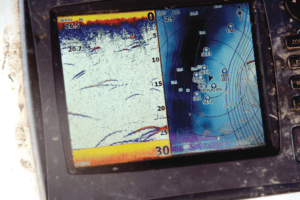
“We had more sturgeon than could be devoured by dog and man, of which the industrious by drying and pounding, mingled with caviar, sorrel, and other wholesome herbs, would make bread and good meat,” wrote John Smith in 1609. The Jamestown settlers were astonished at the size and quantity of the fish, which were so rare in England that if one was caught, it was reserved solely for the king.
Archaeologists have unearthed a layer of artifacts from just before the Starving Time (1609–10) that is filled with scutes, evidence that the colonists were eating sturgeon in the spring of 1609, when the fish would have been running the river during spawning. When the spawning run ended, the fish left, and with winter, the colonists began to starve. Balazik, who was asked by archaeologists to analyze remains uncovered in 2013, found a lateral scute so enormous he believes it came from a fish well over ten feet long.
Sturgeon supported a thriving industry in the Bay. Between 1860 and 1890, smoked sturgeon and roe were shipped all over the country. The harvest peaked in 1890, then crashed. Overfishing and habitat loss through damming of rivers almost wiped out the fish that had survived eons of earth-shattering ecological events. In 1925, Virginia banned harvesting any sturgeon under four feet long; in 1974 it became the first of the states to place a full moratorium on the fish. By 2012, the National Marine Fisheries Service protected five distinct populations of Atlantic sturgeon under the Endangered Species Act, including that segment native to the Chesapeake.
“I convened an expert panel in 1995 and we said sturgeon are extirpated,” Secor says. “We saw subadults, but we didn’t believe spawning was happening. We believed they were visiting from other places. Albert [Spells] was the one holdout. He said, ‘You guys haven’t looked in the right places at the right times.’ ’’
Spells, project leader of the Virginia Fish and Wildlife Conservation Office of the U.S. Fish and Wildlife Service, helped initiate a program in 1999 that rewarded watermen $100 per fish if they found a sturgeon and called scientists to come tag, document and release it. “When we started we knew nothing,” Spells says. And when Balazik began his work, Spells says, every discovery revealed a new mystery.
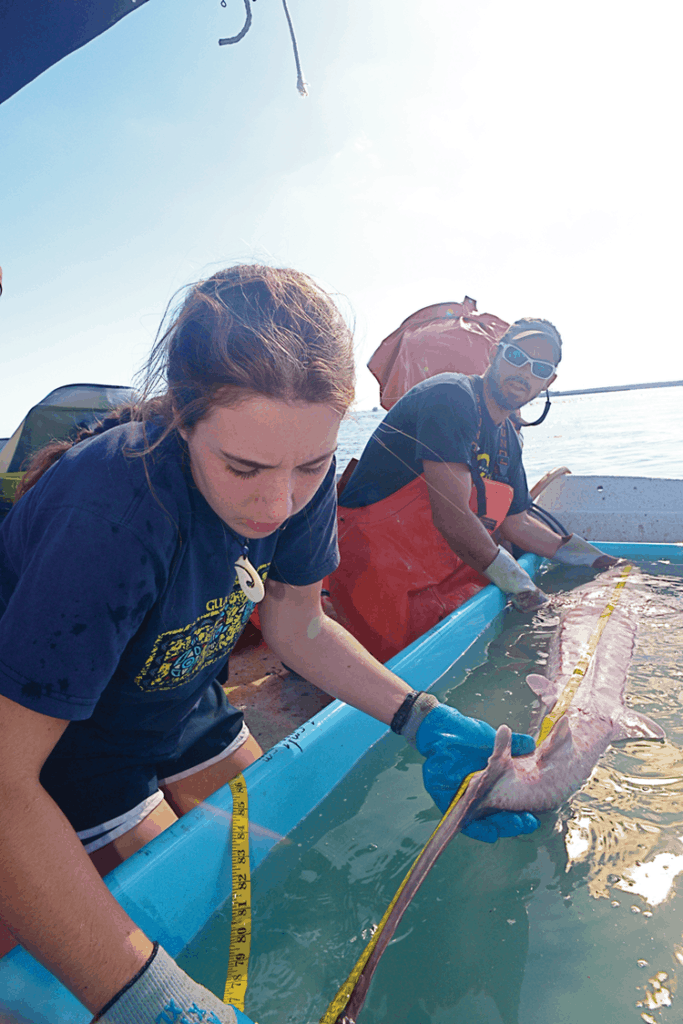
“Matt and I used to have an argument. He said, ‘Albert, these fish are spawning in the fall,’ and I said, ‘There is nothing in the literature or history that says they spawn in the fall,’ He said, ‘Albert, it’s been there in front of us all this time.’ ’’
On the boat out in the James, Balazik and Chuck Frederickson, a former James River Riverkeeper, are putting their backs into hauling in 500 feet of gillnet, constituted of three descending mesh sizes to catch larger to smaller fish. Balazik’s wife, Thiwa, helms the boat. They had waited till the tail end of the flood tide to set the net across the channel, which plunges here into a deep trough. The end of the ebb, Balazik has learned, doesn’t yield as many fish, because the nets don’t set right. It’s one of many tricks he’s learned over the years that have made him the undisputed leader among Bay scientists in the lost art of fishing for sturgeon. Yesterday, he caught eight fish, four of them enormous females. Today, Balazik is admittedly tired from yesterday’s exertions and is choosing only to look for males, who on average are a third of the size of females.
Still, when the telltale bubbles suddenly erupt on the surface—the fish “burping” from its expanding swim bladder—and the fish emerges from the depths like the ghost Secor imagined, pale and otherworldly, it takes all of Frederickson’s and Balazik’s efforts to lift it carefully and quickly into the bottom of the boat onto a bed of netting. Balazik quickly cuts the fish from the gillnet, then bear-hugs it into a full-size horse-watering trough circulating with river water. Four times the two execute this maneuver as the fish come up in the net, until there are four fish, two floating in the big trough, two in a smaller one, their bellies the color of hard-boiled egg. As Balazik and Frederickson secure the net, Thiwa steers the boat from the channel, making sure the fish are breathing well and the water is circulating properly in the tanks.
For the next little while, they process each fish one by one. First, Balazik runs a handheld scanner over the animal to see if it’s already tagged (one is; Thiwa records the tag number, which they will check against a database to find out where this individual comes from). If it’s not, he inserts a PIT tag (passive integrated transponder), then snips a tiny bit of fin, a genetic sample that will help him identify what population each fish is from. Finally, he measures the fish—two separate length measurements and two girth—before lifting it from the tank and returning it to the water. This, like the capturing, is harder than it sounds; the sheer physicality of this field research is one reason few scientists do it.
Today’s fish measure between 163 and 178 centimeters long, with girths of 56 to 69 centimeters. (The biggest female they caught yesterday measured 238 centimeters long.) Balazik estimates these fish are between 11 and 14 years old, all males that have spawned and are seabound.
Through genetic testing, Balazik and his colleagues have made a remarkable discovery: There are two distinct races of sturgeon on the James, those that spawn in the fall, and those that spawn in the spring. The fall spawn, he believes, is a result of the historic decimation of the spring spawning fish. As an ultimate survivor, sturgeon have surely learned to adapt.
Elsewhere in the Bay, scientists have found a distinct spawning population in the upper tributaries of the York River, primarily the Pamunkey River, and they’ve identified spawning fish in the Rappahannock. In the Maryland portion of the Bay, they’re being tracked in the Pocomoke, Nanticoke and Choptank rivers, says Chuck Spence, project leader of the Anadramous Restoration Project with the Maryland Department of Natural Resources. Balazik believes that sturgeon are likely in most of the Bay’s rivers, as well as the East Coast’s waterways. “You just have to go and look,” he says.
 Scientists track the fish through PIT and telemetry tags. Telemetry tags constantly ping a position, which can be tracked and recorded by receivers attached to buoys, docks and other structures as a fish passes by. Scientists from Canada to Florida use the same frequencies and hardware so they can easily share data through the Atlantic Cooperative Telemetry Network. Of the nearly 600 fish that Balazik has tagged over the years in the James, he knows that one has turned up in the Savannah River, another off Connecticut.
Scientists track the fish through PIT and telemetry tags. Telemetry tags constantly ping a position, which can be tracked and recorded by receivers attached to buoys, docks and other structures as a fish passes by. Scientists from Canada to Florida use the same frequencies and hardware so they can easily share data through the Atlantic Cooperative Telemetry Network. Of the nearly 600 fish that Balazik has tagged over the years in the James, he knows that one has turned up in the Savannah River, another off Connecticut.
In December 2012, the U.S. Navy installed an array of more than 70 acoustic telemetry receivers at its facilities and buoys in the lower Chesapeake, its tributaries, and nearshore Atlantic waters. According to a story in the Fall 2015 Endangered Species Bulletin by J. Carter Watterson, a senior fisheries biologist with the Naval Facilities Engineering Command Atlantic in Norfolk, the Navy wants to determine how its activities in these waters might affect the endangered fish. “During the first two years, January 2013 through December 2014, the array recorded more than 615,000 detections of 17 different species and 1,100 individual animals. Of those animals, 653 were Atlantic sturgeon,” the story said.
This tracking, Spence says, enables scientists to learn a great deal about where fish are moving, and when, which sometimes helps them guess the why. For instance, he says, after a big rain event in early October 2015, “the temperature dropped about 10 degrees Celsius, and that was a big cue for them to get out of Dodge, and they all headed out [of the Nanticoke.]” DNR maintains 26 receivers in the Nanticoke River system alone with the majority in Marshyhope Creek where a waterman clued Spence and others onto the presence of sturgeon because he saw them breaching. “In 2014, we finally figured out how to fish for them,” he says. “That was the year we caught our first fish. This year [2016] was kind of exciting for us because we caught the biggest fish we have so far, seven feet, eight inches long and weighed 154 pounds, a female.” They also caught four males, two previously tagged. “One of the Nanticoke fish, turned up in Charleston, S.C., ” he said. That sturgeon are here, there’s no question. But where, and how successfully they are spawning is an entirely separate question, one that scientists are still trying to answer. Sturgeon eggs are sticky and require a hard, pebbly bottom to attach to. Turbidity and sedimentation after a heavy rain, for instance, or longer term through erosion runoff—the bane of so many species in the Bay—can wipe out that critical habitat and make spawning useless. Similarly, larvae depend on clean, structured habitat—crevices and the like—for protection from predators. And, they need decent water quality.
Though he has been studying sturgeon for 30 years, Dave Secor has yet to catch one in the wild. And what he’s looking for now on Marshyhope Creek is even more elusive than the adults, and those are eggs and larvae—hard evidence that they are successfully spawning. Using benthic maps of the Marshyhope and Nanticoke developed by NOAA’s Chesapeake Bay office, Secor can guess where the fish might be spawning, based on that need for pebble-cobble bottom. This year (2016) for the first time, he and his colleagues placed a few hundred egg collection mats on the bottom where they suspected the fish might be spawning. So far, they’ve struck out.
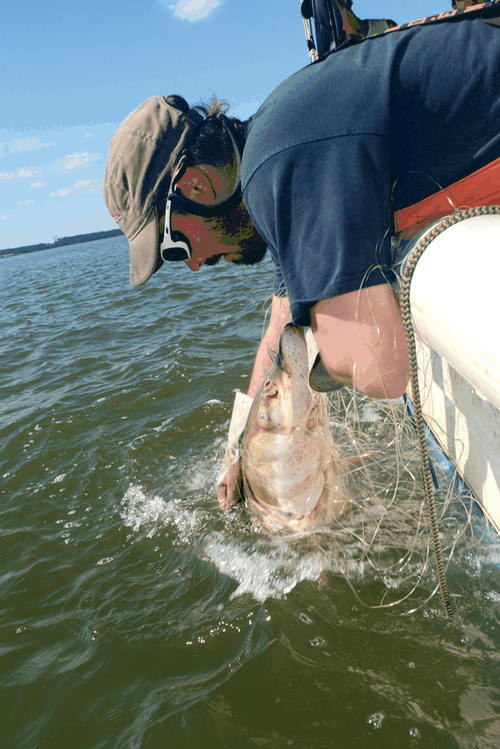
Similarly, we still know very little about population numbers. “It’s a really important question: Are they making a comeback, or were they there all the time and we didn’t know it?” Secor says. One way to guesstimate an answer is to use genetic samples of sturgeon taken off the coastal waters of New York and New Jersey in the 1990s and determine how many of them were James River fish, now that Balazik has genetically identified the James’ two races. Today, about 20 percent of the fish sampled in those waters are from the James. “When they did the genetics in the ’90s, they didn’t have any baseline for the James River,” Secor says. “Now they do, and we can go back and analyze it.”
As we head back up the James with Balazik, we’re abreast of Jamestown Island when we spot something big and white floating. It’s a male sturgeon, sliced in half by the big propeller of a commercial vessel. Balazik hauls it aboard and scans it for a tag; nothing. It’s far from the first of these he’s found. “This is a bad time of year for them,” he says. “When they’re heading out, they move up in the water column and they are susceptible to getting hit by big props—ships, ferries. This is one of my fights no one wants to take on.”
Secor agrees with him, citing ship strikes as the top threat to spawning populations of sturgeon in the Bay and its tributaries. “We now know that they’re moving into such narrow, small sections of tributaries and interacting with traffic,” he says. It’s a powerful industry in which to try and effect a change, he says, “but that’s the one that could have a huge immediate benefit to sturgeon.”
And while water quality and habitat loss continue to threaten the fish’s recovery, another specter looms in a competing species, the blue catfish. Scientists are extremely concerned that this invasive, dominant predator could easily be wiping out young sturgeon. Conducting surveys for young fish, they say, is the next step in assessing the question of whether the fish will survive here.
The research happening now is laying the critical groundwork for learning even more about sturgeon, which in turn will help scientists and fisheries managers understand what needs to be done to support their potential recovery on the Bay. But it’s Spells, the Virginia scientist who’s says he’s been studying sturgeon since “we knew nothing,” who sums up most succinctly this enigmatic Chesapeake treasure: “It is mysterious, still. We know more than we’ve known about sturgeon in the Chesapeake forever, but I think every time we learn something, we realize we don’t know a whole lot.”
To see Sturgeon in action, watch this video from James River Association:

